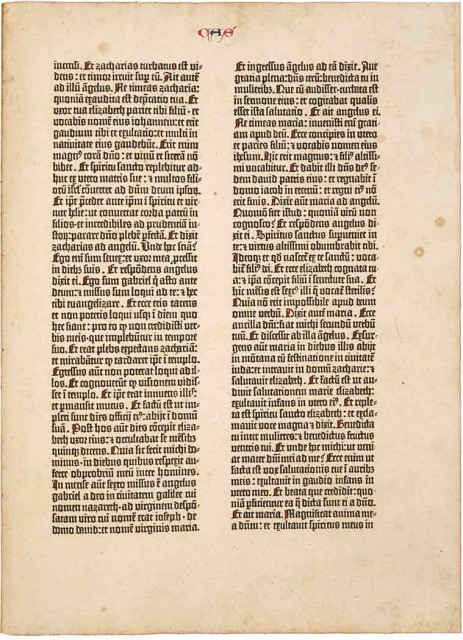The Gutenberg Bible
01/05/2017 Books & Autographs

The origins of printing are closely tied to Johannes Gensfleisch zur Laden zum Gutenberg, more commonly referred to simply as Johann Gutenberg. While printing from movable types had been practiced in China and Korea as early as the 11th century, it was unknown in Europe before Gutenberg; only relief printing from incised blocks was practiced, and that for only limited applications. Gutenberg was a skilled metalworker (he was both a blacksmith and a goldsmith), and his realization that individually cast letters could be assembled and used as a printing surface for any text revolutionized the way books were produced, enabling texts to be propagated relatively quickly and extensively. It is possible (indeed likely) that he had produced earlier works before the Bible that bears his name, and with which he is most closely associated; one candidate (printed in Gutenberg’s types) is the Sibyllenbuch, a work that exists as only one fragment and which is dated to "about 1452–53" by the British Library. Additionally, an edition of Donatus’s Latin grammar was likely also issued by Gutenberg. Though only fragments of this book exist (it was likely read to pieces), it likely also preceded the great 42-line Bible in Latin issued from his press in Mainz in about 1455.
That book is as beautiful an example of Gothic printing as any to emerge in the period before 1501. Printed books produced in this era are commonly referred to by the Latin incunabula; this term has the sense of “cradle” “or “swaddling clothes,” hence a reasonable and commonly accepted translation is “cradle books.” The relative perfection of the Bible has led many to assume that printing somehow emerged from Gutenberg’s workshop as a fully accomplished art, though as I have indicated, there were likely many trial works by him that have not come down to us. Still, by any yardstick it is a magnificent accomplishment: an imposing pair of folio volumes, the Old and New Testament, with 1,286 pages printed in two columns. Copies exist printed on both paper and vellum. Perhaps only 180 copies were completed, of which a mere 21 are known to survive complete, with a further 28 incomplete examples extant.
The birth of the book was fraught with difficulties. It was a very expensive production, and Gutenberg had borrowed money from the wealthy merchant Johannes Fust as early as 1450 for his printing endeavors. In November of 1455, as work on the Bible was rapidly approaching completion, Fust filed a lawsuit in the Court of the Archbishop of Mainz attempting to recover money he had invested. The precise outcome of this lawsuit (documented in the Helmasperger Notarial Instrument and apparently nowhere else) seems unclear. It is likely that, one way or another, Fust was made whole (and certainly acquired a portion of the edition), but there is controversy as to whether Gutenberg lost control of his press as a result of the action. In any case, as a result of his legal maneuverings, Fust’s name is also associated with the Bible.
From a very early time, the book was extremely desirable. Copies supposedly changed hands shortly after publication for very large sums (up to 30 florins, a huge sum for the time, representing several years of wages for a skilled worker). Today only one copy is known with certainty to have been privately held, and most copies unquestionably went to monasteries and universities. The book rapidly became a desideratum for any bibliophile. Cardinal Mazarin, Chief Minister to the King of France from 1642 until his death in 1661, held a copy in his personal library, and indeed Gutenberg’s Bible is still occasionally referred to as the Mazarin Bible, such was this great collector’s esteem for the work. His copy is still in the Bibliothèque Mazarine today. Of the extant examples, all are in institutional holdings or are in collections, such as that of the Bodmer Library (which is now a quasi-public institution), from which they are unlikely ever to emerge.
Thus, the opportunity to acquire even an individual leaf is a remarkable opportunity. That offered in the Doubleday Collection results from the 1920 acquisition by the New York bookseller and publisher Gabriel Wells of the imperfect copy ultimately originating from the Court Library of Mannheim. Sold in November 1920, it was lacking 50 of its 643 leaves. Numbers of the remaining leaves had the lower margins cut away, and others had losses where illuminations had been extracted. Given the overall condition, Wells decided that it would make fiscal sense to sell the book by the leaf (and where possible, by complete books of the Bible). This was less of a heresy in 1921 than this seems today. His action enabled the New York Public Library copy to be brought to a state closer to completion, for with Wells's gift of leaves only one leaf then remained lacking from its copy. Other institutions were similarly able to perfect or partially perfect defective copies. For a price of $150, many private collectors were able to purchase a leaf of the Editio Princeps of the Bible and the first substantial book printed from moveable type.
The Doubleday copy is especially desirable as it contains a New Testament leaf from the Gospel according to Luke. The Latin text contains Luke's account of the birth of John the Baptist, the Annunciation, and the first part of the Nativity including the birth of Jesus; in short, Luke's familiar account of the events leading up to, and including, the birth of Jesus. A more compelling single leaf from the first printed Bible is hard to imagine.
The leaf from the Gutenberg Bible is offered as lot 100 in the January 11, 2017 auction of The Nelson Doubleday, Jr. Collection.